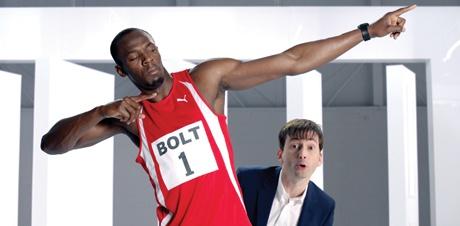What's the language of your brand?
Creating a unified ‘tone of voice’ across all channels of communication that speaks your target audience’s language is a way of making yourself heard above the market chatter.
A picture says a thousand words but for brands trying to reach out to new and existing customers, verbal and written language is becoming as important as visual identity in marketing communications.
O2 says the right tone of voice is a “weapon” for brand building, while Nationwide and Cisco are experimenting with language to ensure differentiation and improve customer experience.
“Yes, we have our logos, our bubbles and colour palette but language for me is one of our biggest brand-building weapons,” says Kat Ward-Smith, head of campaigns and brand experience, O2.
“We have 23 million customers, 10,000 employees and every minute of the day we are talking to those customers and trying to find new ones. We can make a beautiful TV ad and do the billboards but it is that one-to-one daily conversation that is also important.”
Brands [globally] spend $13bn (£8.7bn) a year on visual identity and just $2bn on verbal identity, according to language consultancy Lingua Brand. The disparity in spend may be due to the fact that how a brand speaks to people is not something that often gets feedback from customers.
It can also be difficult to measure the effect of language on customers’ overall experience of its service, according to Nationwide senior manager of customer experience at Nationwide, Caroline Hobbs, speaking at an event organised by writing and brand language consultancy The Writer.
“Customers don’t comment or complain about language, so you have to find out for yourself,” she says.
Working with The Writer, Nationwide defined the language of the ‘On Your Side’ tone of voice that appears in its marketing communications and produced a set of guidelines that could be used by anyone producing written communications within the company.
It’s important people feel they are engaging with someone they can identify with rather than just a big brand
“The financial services sector and the banks in particular appear to communicate in a very formal way, and stringent regulation can mean financial product and brand messages get projected as sterile and complex at times.
“As a building society we wanted to reflect our closeness to our customers,” says Nationwide’s divisional director for customer strategy and marketing Andy McQueen.
The brand therefore made its communications easier to understand by trying to speak in the customer’s language rather than in financial jargon. This is in the process of being rolled out and is initially being implemented through the brand’s marketing campaigns.
“It’s being received really well. Internally it has helped provide clarity and unified understanding of how we deliver our ‘On Your Side’ promise in our communications,” says McQueen.
Eradicating jargon internally and externally has also helped Cisco. It aimed to change the way in which it was seen by customers, employees and shareholders by changing how it communicates, defining and rolling out its tone of voice, which employees have adopted.
The brand initially undertook research on its own business-to-business customers as well as the end consumer and found there was a lack of connection between the internal communications and employees; teams were talking to each other but not understanding and core parts of the business didn’t get what the other parts were saying.
This was because engineers who developed the products were the ones naming and describing them. Those names were used internally and then externally by the salesforce and marketing departments, among others. However, Cisco’s customers didn’t fully understand the product terms.
“Customers felt like they were wasting time – and these are people that are advocates, evangelising our solutions and services,” says Michael Lenz, director of brand experience at Cisco. “The experience demanded clarity in the [tone of] voice and how we presented ourselves to our customers.”
Lenz adds: “When we are designing the brand experience there are steps and foundational pieces that need to be put in place, one of which systemically we had to fix and that was language.”

Virgin Media
Working with consultancy The Writer, Cisco developed a ‘playbook’: a set of language guidelines that reflect the brand’s values that were translated into 14 different languages.
Being clear in its tone of voice also prompted O2 to recently begin rewriting propositions as if they were a tweet or an email, getting rid of extra words. “If I’m talking about something in the financial market, I won’t use the jargon because that is expected,” explains Ward-Smith at O2. “It simplifies it and again that helps make the brand different from any other financial market that is talking about the same product.”
The brand’s marketing to promote its entry into the 4G sector avoids technology speak and instead encourages people to ‘be more dog’[1], by which it means to be inquisitive and excitable about life.
In the charity sector, it is also important for brands to consider how they communicate with people. The Macmillan charity has tone of voice guidelines as well as other initiatives, some mandatory and some not, to help employees ensure they are using the right language and tone. It’s a business that has to be very careful how it communicates, given it supports people with cancer and their families.
Barbara Cormie, its creative services manager, says: “With 1,200 staff and other people writing on our behalf it’s very important to have a way of explaining everything clearly. The guidelines are only one way; we also offer an awful lot to staff in terms of improving the understanding of our brand identity overall.”
Cormie adds: “It’s vital to have ‘one voice’, which helps build the brand and trust in Macmillan and, crucially, inspires people to get involved. Our tone is used across everything we do, from email upwards. So we have a unifying set of principles but can ‘dial up or down’ various aspects as appropriate for different audiences and contexts.”
Finding a tone of voice and preparing a set of language guidelines is just the first step; it is the execution of that in different channels that can be where the challenges lie, especially for businesses that have many brands under one umbrella.
McQueen at Nationwide says: “The marketing channels such as TV, print and online are admittedly the most straightforward to embed the tone of voice into but we’ve also just concluded a refresh of our entire mobile SMS service messaging using this new tone of voice.
“We are also undertaking a review of our wider customer service communications and embedding the understanding of the tone of voice in our customer teams. It’s still early days but we’re making good progress.”
LV= also sees one of its biggest challenges as making sure the brand and tone of voice is “adaptable enough to talk to different people at different times without losing the core of what it is as a brand”, according to marketing manager Nick Whitnell.
While insurance is its mass-market product, LV= also deals with retirement and savings and investments, and B2B as well as business-to-consumer sectors.
Consistency across channels and time is also key in the execution of brand language. “If you chop and change or try too hard, people aren’t going to stay with you,” says Dan Germain, head of creative at Innocent (see Q&A). Innocent is well-known for its irreverent tone of voice, just as Virgin Media is known for its humour.
Insurance isn’t the most exciting of sectors but people still want to make sure they are not confused
Richard Larcombe, director of advertising and sponsorship at Virgin Media[2], describes the brand’s language as a dial that can be turned up or down. For example, the mischievous nature of the brand in a TV ad starring actor David Tennant (pictured above) might be turned up to deliver a message about new features of a TiVo box or dialled down in direct-response communication talking about price or value – but the brand characteristic remains constant.
Larcombe adds: “Living up to the Virgin brand is a privilege and very much a business necessity. It’s not only our products and services that differentiate us, it’s also our brand and our people.
“We use the idea of a ‘Red Thread’ that all communication – acquisition, retention or service – hangs off. Clearly, there will be a certain degree of flexibility in delivery but the overall tone will be consistent across written, visual and audio communications.”
Since its rebrand in 2007, LV= has remained consistent, claims Whitnell. “A lot of companies chop and change their campaigns, and because we have spent longer being consistent, we have developed and refined how we talk to customers.”
For LV= (pictured below) this universal tone of voice doesn’t operate in silos across the company – the marketing team works on everything from the recorded message on telephones, through to how operations talks to customers and how insurance documents are written.

LV=
Whitnell adds: “We make sure that documents are clear to customers. We understand insurance isn’t the most exciting of sectors but people still want to make sure they are not confused, so we treat people with the respect they deserve.”
Tone of voice can be tricky for certain brands on social media, particularly those which take a corporate stance in the rest of their communications. The channel does allow for a chattier style but consistency is also key.
Virgin’s Larcombe says: “Across social platforms, the core of the brand’s personality doesn’t change, it simply adapts to the environment: it becomes much more conversational, particularly when we’re responding to a customer. It’s important people feel they are engaging with someone they can identify with rather than just a big brand. Social media also allows us to be more playful.”
Choice of language can also pay dividends when reacting to a crisis. When O2 experienced a network outage that caused outrage from its customers on Twitter, the social media team responded to every single tweet in a personal way rather than using a standard corporate apology. The brand usually gets 120 tweets a day and that number rose to 13,500 during the outage.
However, Ward-Smith says that “sometimes we need to pull them back”, referring to a time when the company used street slang to respond to a customer query via Twitter. “It did cause a little bit of ‘Oh, my god’ when it came out. Nobody knew what was happening. It worked, though”.
Language is clearly important to businesses: it can either steer a consumer through choosing a brand’s products or services or put them off, and the experience will determine whether it is a name they notice, will buy from and whether they will repeat that purchase to become brand advocates.
References
- ^ encourages people to ‘be more dog’ (www.marketingweek.co.uk)
- ^ Virgin Media (www.marketingweek.co.uk)









